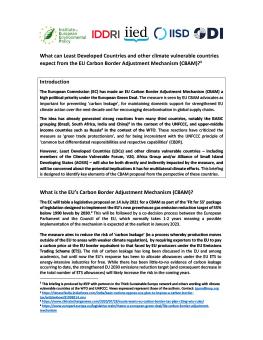
What Can Least Developed Countries and Other Climate Vulnerable Countries Expect from The EU Carbon Border Adjustment Mechanism (CBAM)?
This briefing examines what the upcoming European Commission proposal for a CBAM could mean for least developed countries and other countries that are particularly vulnerable to climate change.
The upcoming European Commission proposal for the CBAM is scheduled for formal release on July 14, 2021, with the international trade and climate policy community alike watching closely to see what the mechanism could entail.
The coming months are then expected to see intense haggling among the EU institutions for a final version of the CBAM, which will be part of the bloc's wider "Fit for 55" package of climate and energy legislation designed to meet its emissions reduction target of 55 percent relative to 1990 levels by 2030.
As this process unfolds, how the CBAM will affect those countries most vulnerable to climate change - including least developed countries and small island developing states - is a crucial question and one that merits greater attention.
This briefing explains:
- the differences between the draft language of the European Commission proposal and the European Parliament's position, and what these options mean for climate vulnerable countries;
- which climate vulnerable countries will be most affected, considering which sectors are likely to be covered under the early stages of a CBAM, which countries rely strongly carbon-intensive sectors, and which countries count the EU as a major export market;
- what the CBAM could mean for international climate action efforts under the United Nations Framework Convention on Climate Change (UNFCCC);
- how the revenues from the CBAM could support the transition to low-carbon economies abroad and why the final CBAM should adopt this approach; and
- how the design of this CBAM and complementary measures can account for the interests of least developed countries and other climate vulnerable economies and why it is crucial to have an integrated strategy on trade, development, and climate.
This joint briefing was prepared by the Institute for European Environmental Policy (IEEP), the Institute for Sustainable Development and International Relations (IDDRI, by its acronym in French), the International Institute for Environment and Development (IIED), IISD, and the Overseas Development Institute (ODI).
Participating experts
You might also be interested in
Net-Zero Should Not Be a Net Loss for Low-Income Economies
As countries make the transition towards net-zero economies, what do these policies mean for international trade?
Can Trade in Electric Vehicle Raw Materials Create Development Opportunities?
As demand grows for electric vehicles, there are valuable lessons to learn from Chile and the Democratic Republic of the Congo.
How Can Trade Maximize Gains From Clean Energy Investment in Developing Countries?
As governments increasingly turn to trade policy to support the renewable energy transition, they also need to encourage the production of key components at home.
Carbon border adjustment unfair on developing countries
The new carbon border adjustment approach by players in the global multilateral trading system is a new phenomenon to address climate change issues.